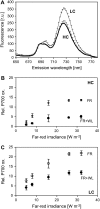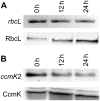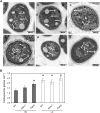Long-term response toward inorganic carbon limitation in wild type and glycolate turnover mutants of the cyanobacterium Synechocystis sp. strain PCC 6803
- PMID: 17600135
- PMCID: PMC1949882
- DOI: 10.1104/pp.107.103341
Long-term response toward inorganic carbon limitation in wild type and glycolate turnover mutants of the cyanobacterium Synechocystis sp. strain PCC 6803
Abstract
Concerted changes in the transcriptional pattern and physiological traits that result from long-term (here defined as up to 24 h) limitation of inorganic carbon (C(i)) have been investigated for the cyanobacterium Synechocystis sp. strain PCC 6803. Results from reverse transcription-polymerase chain reaction and genome-wide DNA microarray analyses indicated stable up-regulation of genes for inducible CO(2) and HCO(3)(-) uptake systems and of the rfb cluster that encodes enzymes involved in outer cell wall polysaccharide synthesis. Coordinated up-regulation of photosystem I genes was further found and supported by a higher photosystem I content and activity under low C(i) (LC) conditions. Bacterial-type glycerate pathway genes were induced by LC conditions, in contrast to the genes for the plant-like photorespiratory C2 cycle. Down-regulation was observed for nitrate assimilation genes and surprisingly also for almost all carboxysomal proteins. However, for the latter the observed elongation of the half-life time of the large subunit of Rubisco protein may render compensation. Mutants defective in glycolate turnover (DeltaglcD and DeltagcvT) showed some transcriptional changes under high C(i) conditions that are characteristic for LC conditions in wild-type cells, like a modest down-regulation of carboxysomal genes. Properties under LC conditions were comparable to LC wild type, including the strong response of genes encoding inducible high-affinity C(i) uptake systems. Electron microscopy revealed a conspicuous increase in number of carboxysomes per cell in mutant DeltaglcD already under high C(i) conditions. These data indicate that an increased level of photorespiratory intermediates may affect carboxysomal components but does not intervene with the expression of majority of LC inducible genes.
Figures






Similar articles
-
Metabolome phenotyping of inorganic carbon limitation in cells of the wild type and photorespiratory mutants of the cyanobacterium Synechocystis sp. strain PCC 6803.Plant Physiol. 2008 Dec;148(4):2109-20. doi: 10.1104/pp.108.129403. Epub 2008 Oct 22. Plant Physiol. 2008. PMID: 18945936 Free PMC article.
-
Modulation of the major paths of carbon in photorespiratory mutants of synechocystis.PLoS One. 2011 Jan 21;6(1):e16278. doi: 10.1371/journal.pone.0016278. PLoS One. 2011. PMID: 21283704 Free PMC article.
-
The plant-like C2 glycolate cycle and the bacterial-like glycerate pathway cooperate in phosphoglycolate metabolism in cyanobacteria.Plant Physiol. 2006 Sep;142(1):333-42. doi: 10.1104/pp.106.082982. Epub 2006 Jul 28. Plant Physiol. 2006. PMID: 16877700 Free PMC article.
-
Does 2-phosphoglycolate serve as an internal signal molecule of inorganic carbon deprivation in the cyanobacterium Synechocystis sp. PCC 6803?Environ Microbiol. 2015 May;17(5):1794-804. doi: 10.1111/1462-2920.12638. Epub 2015 Jan 7. Environ Microbiol. 2015. PMID: 25297829
-
Photorespiratory 2-phosphoglycolate metabolism and photoreduction of O2 cooperate in high-light acclimation of Synechocystis sp. strain PCC 6803.Planta. 2009 Sep;230(4):625-37. doi: 10.1007/s00425-009-0972-9. Epub 2009 Jul 4. Planta. 2009. PMID: 19578872 Free PMC article.
Cited by
-
Diurnal metabolic control in cyanobacteria requires perception of second messenger signaling molecule c-di-AMP by the carbon control protein SbtB.Sci Adv. 2021 Dec 10;7(50):eabk0568. doi: 10.1126/sciadv.abk0568. Epub 2021 Dec 8. Sci Adv. 2021. PMID: 34878830 Free PMC article.
-
Flavodiiron proteins in oxygenic photosynthetic organisms: photoprotection of photosystem II by Flv2 and Flv4 in Synechocystis sp. PCC 6803.PLoS One. 2009;4(4):e5331. doi: 10.1371/journal.pone.0005331. Epub 2009 Apr 24. PLoS One. 2009. PMID: 19390625 Free PMC article.
-
Linking the Dynamic Response of the Carbon Dioxide-Concentrating Mechanism to Carbon Assimilation Behavior in Fremyella diplosiphon.mBio. 2020 May 26;11(3):e01052-20. doi: 10.1128/mBio.01052-20. mBio. 2020. PMID: 32457252 Free PMC article.
-
Competition between cyanobacteria and green algae at low versus elevated CO2: who will win, and why?J Exp Bot. 2017 Jun 1;68(14):3815-3828. doi: 10.1093/jxb/erx027. J Exp Bot. 2017. PMID: 28207058 Free PMC article.
-
Rubisco packaging and stoichiometric composition of a native β-carboxysome.bioRxiv [Preprint]. 2024 Sep 21:2024.09.20.614183. doi: 10.1101/2024.09.20.614183. bioRxiv. 2024. Update in: Plant Physiol. 2024 Dec 24;197(1):kiae665. doi: 10.1093/plphys/kiae665. PMID: 39345498 Free PMC article. Updated. Preprint.
References
-
- Badger MR, Price GD, Long BM, Woodger FJ (2006) The environmental plasticity and ecological genomics of the cyanobacterial CO2 concentrating mechanism. J Exp Bot 57 249–265 - PubMed
-
- Bedu S, Pozuelos P, Cami B, Joset F (1995) Uptake of inorganic carbon in the cyanobacterium Synechocystis PCC6803: physiological and genetic evidence for a high-affinity uptake system. Mol Microbiol 18 559–568 - PubMed
-
- Berry S, Schneider D, Vermaas WFJ, Roegner M (2002) Electron transport routes in whole cells of Synechocystis sp. strain PCC 6803: the role of the cytochrome bd-type oxidase. Biochemistry 41 3422–3429 - PubMed
-
- Bradford M (1976) A rapid and sensitive method for the quantitation of microgram quantities of protein utilizing the principle of protein-dye binding. Anal Biochem 72 248–254 - PubMed
-
- Bukhov N, Carpentier R (2004) Alternative photosystem I-driven electron transport routes: mechanisms and functions. Photosynth Res 82 17–33 - PubMed
Publication types
MeSH terms
Substances
LinkOut - more resources
Full Text Sources
Miscellaneous

